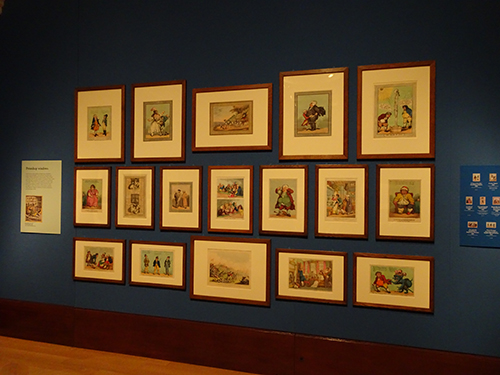There are more than a thousand works by the Georgian satirical cartoonist Thomas Rowlandson (1758 – 1827) in the Royal Collection. The Prince of Wales (later George IV) bought most of these, not as a connoisseur (which he was), but rather in a vain attempt to reduce the circulation – among the aristocracy at any rate, for he always bought the best examples. Queen Victoria, by contrast, adored them. We’d like to think that her reputation as a dour moralist has by now been well and truly scotched.
Rowlandson, like his exact contemporary James Gillray, was a Londoner. As an artist he was formally trained. He was a bon viveur, a prankster. Any money he had, he spent. He sometimes lived in damp and dismal accommodation. But free spirit that he was, he knew he could draw his way out of trouble when he needed to, and he did. His work wasn’t as angry as Gillray’s nor as moralising as Hogarth’s before him. One senses it was a bit cleverer than theirs; that ideas came to him more easily and simply flew off his pen as they did.
A new show at the Queen’s Gallery features around a hundred examples of Rowlandson’s works from the collection. They clearly demonstrate the scope and facility of his mind and pen. His talent as a caricaturist is demonstrated in this Hogarthian set of “types”.


His more overtly political works take direct pot-shots at Royalty and the leading politicians and celebrities of the day (Pitt the Younger, Fox, Georgiana, Duchess of Devonshire etc.)

A whale which had been beached at Gravesend was making the news, detracting from the Duke of York’s failings. Here he beseeches the creature to stick around.
The nation was fascinated by the French Revolution toward the end of a century of frequent conflict with France. Here are two examples of the same cartoon – The Contrast – demonstrating how English Liberty was far superior to its French equivalent, very much grist to the mill. Overtly propagandistic, the uncoloured version was priced at only 3d, encouraging the widest possible distribution. Very much a you-never-had-it-so-good sentiment. This work also appeared recently at the Magna Carta exhibition at the British Library.

After Trafalgar, there was a possibility that Nelson’s body would be transferred to another ship to be transported home, but the sailors of the Victory were having none of it. No real axe to grind, this patriotic and sentimental print makes the point. Nelson’s body was conveyed in a barrel of brandy of course, but hey.

It would another half century before cartoons like this appeared in newspapers and magazines. They were distributed individually from print shops at prices ranging typically from one to eight shillings. Collectors tended to mount them in volumes to be handed around on social occasions. Buyers and those who couldn’t afford to collect would eagerly browse the latest examples in print shop windows. The back wall of the exhibition has a selection displayed in this way to give you a sense of the print shop window. I works rather well.

And here is a rare and interesting survival: a screen decorated with cut-outs from the leading satirical prints. The wealthy could afford both to collect prints and to cut them up.


These examples can but give you a tiny taste of the show, for this is a substantial and important exhibition, a must for anyone interested in the late-Georgian satire boom, the likes of which were not seen again until the early 1960s.
High Spirits: The Comic Art of Thomas Rowlandson, runs at the Queen’s Gallery, Buckingham Palace
from Friday, 13 November 2015 to Sunday, 14 February 2016. Entrance is £10.00
Note. Included in your ticket is another quite exquisite exhibition running in the gallery over the same period: Masters of the Everyday: Dutch Artists in the Age of Vermeer.
All images courtesy Royal Collection Trust. Photos: Mike Paterson.